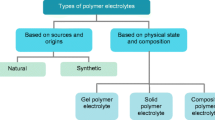Abstract
A series of conducting thin-film solid electrolytes based on poly (vinyl alcohol)/ poly (vinyl pyrrolidone) (PVA/PVP) polymer blend was prepared by the solution casting technique. PVA and PVP were mixed in various weight percent ratios and dissolved in 20 ml of distilled water. The samples were analyzed by using impedance spectroscopy in the frequency range between 100 Hz and 1 MHz. The PVA/PVP system with a composition of 80% PVA and 20 wt.% PVP exhibits the highest conductivity of (2.2±1.4) × 10−7 Scm−1. The highest conducting PVA/PVP blend was then further studied by adding different amounts of potassium hydroxide (KOH) ionic dopant. Water has been used as solvent to prepare PVA/PVP-KOH based alkaline solid polymer blend electrolyte films. The conductivity was enhanced to (1.5 ± 1.1) × 10−4 Scm−1 when 40 wt.% KOH was added.
Similar content being viewed by others
6. References
B.B. Owens, P.M. Skarstad and D.F. Untereker, ‘Solid-electrolyte cells’, in: Handbook of Batteries (D. Linden, Ed.) 2nd Edition, McGraw-Hill, New York, 1994, Ch. 15.1–15.28.
D.A.J. Rand, ‘Battery system for electric vehicles: State of art review’, J. Power Sources4, 101–143 (1979).
J.F. Fauvarque, S. Guinot, N. Bouzir, E. Salmon, and J.F. Penneau, ‘Alkaline poly-(ethylene oxide) solid polymer electrolytes. Appli-cation to nickel secondary batteries’, Electrochim. Acta40, 2449–2453 (1995).
S. Guinot, E. Salmon, J.F. Penneau, and J.F. Fauvarque, ‘A new class of PEO-based SPEs: Structure, conductivity and application to alkaline secondary batteries’, Electrochim. Acta43, 1163–1170 (1998).
N. Vassal, E. Salmon and J.F. Fauvarque, ‘Nickel metal hydride secondary batteries using an alkaline solid polymer electrolyte’, J. Electrochem. Soc.146, 20–26 (1999).
A. Lewandowski, M. Zajder, E. Frackowiak and F. Beguin, ‘Supercapacitor Based on Activated Carbon and Polyethylene Oxide-KOH-H2O Polymer Electrolyte’, Electrochim. Acta46, 2777–2780 (2001).
A. Lewandowski and K. Skorupska, ‘Alkaline Poly(vinyl alcohol)-KOH-H2O Solid Polymer Electrolyte’, Polish J. Chem.72, 2635–2638 (1998).
A. Lewandowski, K. Skorupska and J. Malinska, ‘Novel Poly(vinyl alcohol)-KOH-H2O Alkaline Polymer Electrolyte’, Solid State Ionics133, 265–271 (2000).
A.A. Mohamad, N.S. Mohamed, Y. Alias, and A.K. Arof, ‘Studies of alkaline solid polymer electrolyte and mechanically alloyed polycrystalline Mg2Ni for use in Nickel-Metal Hydride batteries’, J. Alloys Comp.337, 208–213 (2002).
C.C. Yang, and S.J. Lin, ‘Preparation of composite alkaline polymer electrolyte’, Mater. Let.57, 873–881 (2002).
C.C. Yang, ‘Polymer Ni-MH battery based on PEO-PVA-KOH polymer electrolyte’, J. Power Sources109, 22–31 (2002).
C.C. Yang and S.J. Lin, ‘Alkaline composite PEO-PVA-glass-fibre-mat polymer electrolyte for Zn-air battery’, J. Power Sources112, 497–503 (2002).
N. Vassal, E. Salmon and J.F. Fauvarque, ‘Electrochemical properties of an alkaline solid polymer electrolyte based on P(ECH-co-EO)’, Electrochim. Acta45, 1527–1532 (2000).
R. Othman, W.J. Basirun, A.H. Yahaya and A.K. Arof, ‘Hydroponics gel as a new electrolyte gelling agent for alkaline zinc-air cells’, J. Power Sources103, 34–41 (2001).
C. Iwakura, S. Nohara, N. Furukawa and H. Inoue, ‘The possible used of polymer gel electrolytes in nickel/metal hydride battery’, Solid State Ionics148, 487–492 (2002).
X. Zhang, K. Takegoshi and K. Hikichi, ‘Highresolution solid-state13C nuclear magnetic resonance study on poly(vinyl alcohol) and poly(vinyl pyrrolidone) blends’, Polymer33, 712–717 (1992).
R. Mishra and K.J. Rao, ‘Electrical conductivity studies of poly(ethyleneoxide)-poly(vinyl alcohol) blends’, Solid State Ionics106, 1883–1894 (1998).
A. Lewandowski, M. Zajder, E. Frackowiak and F. Beguin, ‘Supercapacitor Based on Activated Carbon and Polyethylene Oxide-KOH-H2O Polymer Electrolyte’, Electrochim. Acta46, 2777–2780 (2001).
A. Lewandowski, K. Skorupska and J. Malinska, ‘Novel Poly(vinyl alcohol)-KOH-H2O Alkaline Polymer Electrolyte’, Solid State Ionics133, 265–271 (2000).
Ch.V. Subba Reddy, A.K. Sharma and V.V.R. Narasimha Rao, ‘Effect of plasticizer on electrical conductivity and cell parameters of PVP+PVA+KClO3 blend polymer electrolyte system’, Journal of Power Sources111, 357–360 (2002).
P.G. Hall, G.R. Davices, I.M. Wara and J.E. Mc Intyre, ‘Conductivity of lithium perchlorate and lithium tetrafluoroborate in tetraethylene glycol dimethyl ether’, Polym. Commun.27, 100–102 (1986).
S. Chandra, S.S. Sekhon, R. Srivastava and N. Arora, ‘Proton-conducting gel electrolyte’, Solid State Ionics154–155, 609–619 (2002).
Author information
Authors and Affiliations
Rights and permissions
About this article
Cite this article
Hatta, F.F., Yahya, M.Z.A., Ali, A.M.M. et al. Electrical conductivity studies on PVA/PVP-KOH alkaline solid polymer blend electrolyte. Ionics 11, 418–422 (2005). https://doi.org/10.1007/BF02430259
Received:
Accepted:
Issue Date:
DOI: https://doi.org/10.1007/BF02430259




